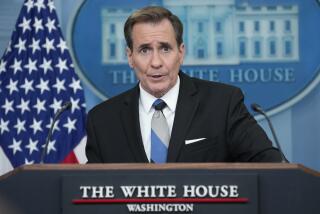U.S. Proposes Bomber, Missile Cuts : Ceilings of 350 Planes and 1,500 Cruise Weapons Offered
- Share via
HELSINKI, Finland — The latest U.S. arms offer to the Soviet Union includes a ceiling of 350 heavy bombers and 1,500 cruise missiles that the bombers can carry, a senior Administration official said Sunday.
The official, traveling with Secretary of State George P. Shultz, outlined further details of the recent U.S. offer at a stopover here on the eve of Shultz’s visit to Moscow.
This will be the first visit by an American secretary of state to Moscow for substantive discussions since 1978. U.S.-Soviet relations foundered the following year when, despite the signing of the second strategic arms agreement, the Soviets invaded Afghanistan, ending the detente period of the 1970s.
The U.S.-Soviet talks in Moscow today and Tuesday will focus on issues on which the two sides may draw closer together and which could lead to some new understanding at the Nov. 19-20 summit between President Reagan and Soviet leader Mikhail S. Gorbachev.
In the new arms proposal, the United States called for a 50% cut in warheads on long-range missiles, down to 6,000 on each side, with a maximum of 3,000 warheads on land-based intercontinental missiles.
Another 1,500 warheads would be on submarine-based ballistic missiles and the rest on bomber-carried cruise missiles.
At present, the U.S. Air Force has 263 B-52 bombers flying, although it is allowed 576 under the strategic arms agreement. The Administration had considered offering to limit the U.S. bomber force to 280, but the Joint Chiefs of Staff reportedly objected. The proposed level was then raised to 350, which is still 50 below the 400 bombers proposed in the Administration’s plan of three years ago.
‘Stealth’ Bombers
With a 350-plane ceiling, the new B-1 bombers now being built can be added to the force without retiring B-52s prematurely, Pentagon officials said earlier. It also provides some flexibility for introducing “stealth” bombers, which promise to be almost invisible to Soviet radar systems, when they are produced in the early 1990s.
In comparison, the Soviets have 375 heavy bombers, according to the Reagan Administration’s count, but this figure includes 230 Backfire bombers, which were classified as medium-range aircraft under the previous strategic arms agreement. The Soviets have only begun to equip their planes with cruise missiles.
The U.S. Air Force currently plans to put a total of 3,000 cruise missiles on B-52s. The new U.S. offer would thus cut that deployment in half, to 1,500.
This is considerably lower than the initial U.S. proposal three years ago to limit air-launched cruise missiles to 4,000, but the Soviets, for their part, want to ban all cruise missiles that have a range greater than 375 miles.
Not only does the new U.S. offer ignore that Soviet desire, but it also says nothing about sea-launched cruise missiles, which the Soviets also want to restrict to the shorter ranges.
According to the official, the ceiling of 1,500 air-launched cruise missiles for bombers would specifically not include nuclear bombs that fall by gravity from the aircraft or short-range rockets carrying nuclear warheads that the B-52 can use as “penetration aids” to suppress enemy air defenses.
U.S. officials complain that under the Soviet arms proposal, the value given to gravity bombs and short-range rockets equals that given to the huge warheads atop Soviet intercontinental missiles. These officials, noting the extensive Soviet air defense systems that would hamper penetration by U.S. bombers, say that the United States cannot accept equating missile warheads with aircraft bombs.
The senior U.S. official traveling with Shultz also confirmed that the new U.S. plan promises that the Administration’s Strategic Defense Initiative for space defense will be conducted “in full conformance” with the Anti-Ballistic Missile Treaty.
The proposal states that the U.S. side “is prepared to and wishes to discuss a cooperative approach” to introducing space defense weapons if current research programs prove them feasible, the official said.
More to Read
Sign up for Essential California
The most important California stories and recommendations in your inbox every morning.
You may occasionally receive promotional content from the Los Angeles Times.










